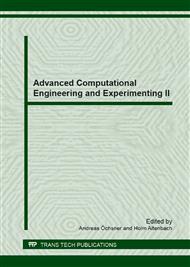p.41
p.47
p.53
p.59
p.67
p.81
p.87
p.93
p.99
Effect of the Shear Force on the Failure of Spatial Concrete Framework Structures
Abstract:
Firstly, the previously developed numerical model for static analysis of spatial concrete frame structures is briefly described. In this model, cross-sections of structural elements can be of arbitrary shape and formed by various materials, with arbitrary normal stress normal strain relations. This model only includes the effect of normal stresses on the structure failure. Here, it was improved by including the effect of shear forces on the failure of reinforced concrete beam elements. Shear bearing capacity of reinforced concrete section includes the concrete capacity, as well as the shear bearing capacity of longitudinal, transversal and inclined reinforcement bars. The developed numerical model and appropriate software were verified on experimental shear test of a concrete beams. Good agreement was obtained between the experimental and the numerical results. However, further verifications of the presented numerical model are needed.
Info:
Periodical:
Pages:
67-80
Citation:
Online since:
June 2013
Authors:
Price:
Сopyright:
© 2013 Trans Tech Publications Ltd. All Rights Reserved
Share:
Citation:


